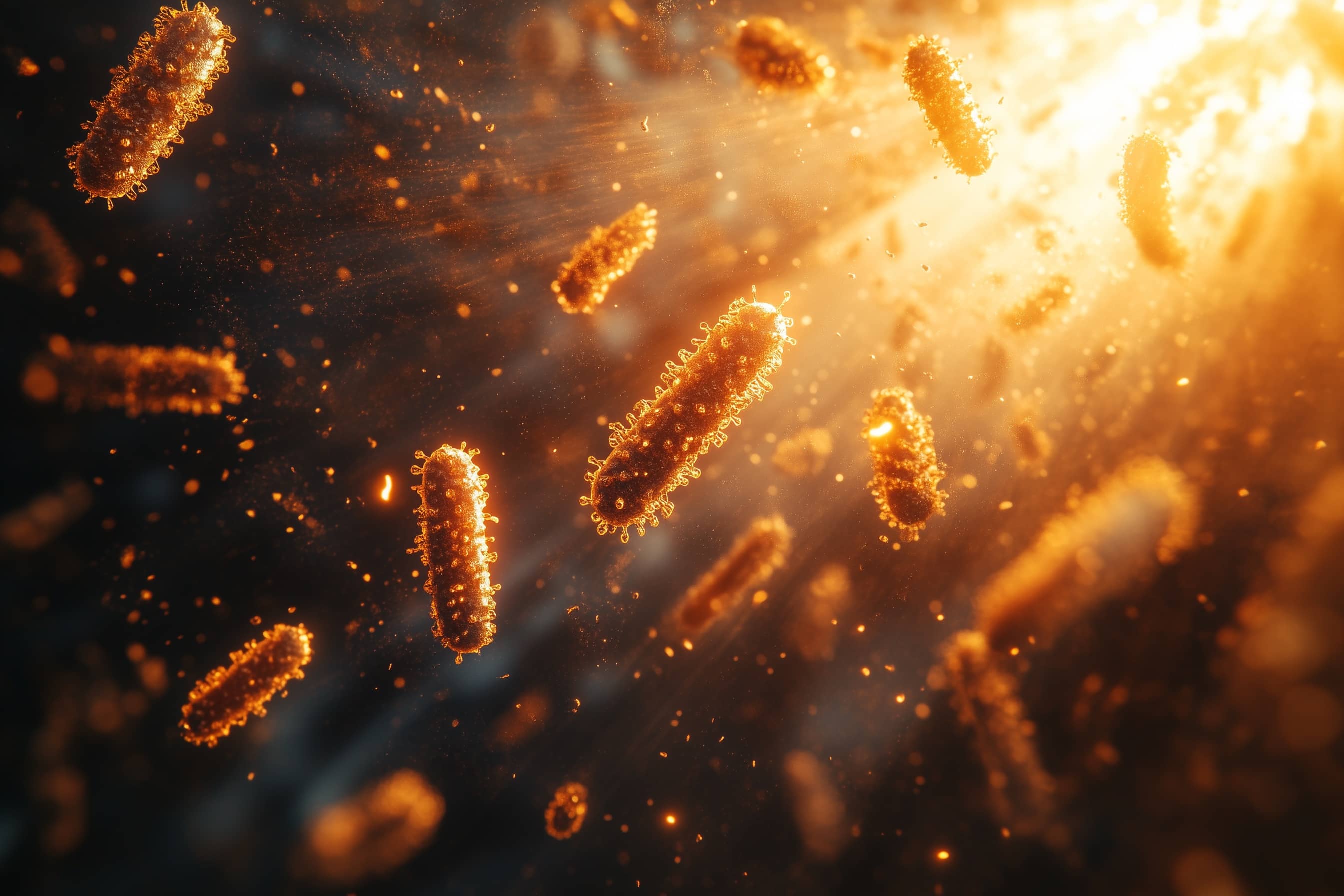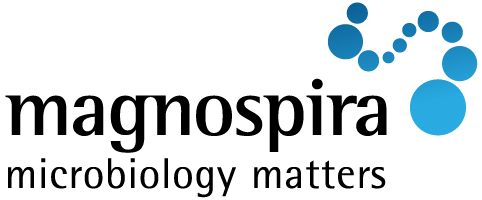Light. Skin. Microbiome.
In this day and age, sunlight is increasingly demonized. Although we intuitively feel how beneficial the sun is for us, whether it’s a long walk in the park in the warming afternoon sun or a sailing trip on the lake, the constant alarm messages from the media and dermatologists about the hole in the ozone layer and skin cancer have created a deep-rooted rejection of the sun’s rays. Yet the sun has extremely important effects on us, without which our survival would be impossible.
Since nuclear fusion ignited our sun around 4.57 billion years ago, it has been considered the “mother of all living things”. Without it, there would be no microorganisms, no plants and certainly no humans in the world. It is the reason why the complex interplay of the natural cycle works, and it determines life and death.
One example is the dinosaurs: the most likely theory for their extinction is the impact of a gigantic asteroid that released an amount of energy equivalent to ten billion atomic bombs. The sunlight blocked by dust and aerosols caused severe cooling, led to the collapse of photosynthesis and resulted in a massive food shortage, which caused the extinction of the dinosaurs.

Light and carbon dioxide are essential
We are well aware of this external dependence on sunlight. We need the oxygen that is produced during photosynthesis under the influence of light, and the resulting sugar is the basis of our energy and building block supply.
The carbon dioxide required for this is not a toxic substance, but enables the reaction that is the basis of life and without which our essential food chain would not function.
Sun against cancer
However, we are less aware of the direct effect of the sun’s rays on humans. Most people are familiar with light-dependent vitamin D synthesis, as there is a deficiency in many countries and supplementation is necessary. However, the fact that sunlight prevents many types of cancer is still new to many.
The sun’s rays have many positive effects on our health
In fact, recent research shows that regular sun exposure is associated with a lower risk of certain internal tumors such as colon, breast, prostate and pancreatic cancers. Sunlight not only helps to prevent deadly cancer, but also reduces the risk of cardiovascular and metabolic diseases such as high blood pressure, obesity and type 2 diabetes. All these diseases are considered typical diseases of civilization. But that’s not all: multiple sclerosis and Alzheimer’s dementia also appear to occur less frequently with sufficient sun exposure, not to mention many mental disorders.
This is not only due to the effects of a sufficient supply of vitamin D, but also to the effects on our immune system and the energy power plants in our cells, the mitochondria.
The sun’s rays provide energy
The high-energy effect that you feel when exposed to sunlight has two main causes. Firstly, more ATP, i.e. more energy, is produced in the cells that are exposed to light. This mainly affects the skin and superficial muscles. Secondly, sunlight helps to regulate the internal clock via the retina. The production of the sleep hormone melatonin is suppressed and the cortisol dynamic changes. Overall, this makes us more alert, more attentive and subjectively more energetic.
How does the sun affect the skin microbiome?
There is clear evidence of a direct effect of the sun on the skin microbiome. Healthy holidaymakers who have been exposed to high levels of radiation for a short time show an altered skin colonization with microorganisms after their return, but this normalizes again after just one month. During the increased exposure to radiation, microorganisms with increased UV resistance in particular become established.
Sun, microbiome and the immune system
The following fact, which was revealed in experiments with mice, is exciting: sunlight has an immunosuppressive effect on every organism, whether mouse or human. This means that the immune response is reduced for a certain period of time – a braking effect, so to speak. The immune system reacts weaker and slower to intruders or abnormalities such as developing cancer cells. In our body, there are almost constant mutations in our cells. These occur when the continuously occurring DNA damage is repaired incorrectly and thus “burned” into the DNA.

These so-called somatic mutations are permanently monitored by the immune system and largely kept in check. Around 300 billion cells are created every day, mainly in the blood and intestinal wall. A large proportion of all cell divisions (typically > 70 %) result in one or more somatic mutations.
The body produces 300 billion new cells every day
Most are neutral and have no consequences. Clonal growth is limited by repair and control mechanisms. The immune system plays an important role, but cannot routinely eliminate all mutated cells. Nevertheless, cancer can only develop if the cells have escaped the immune system, carry several specific mutations and are able to multiply.
If the skin is exposed to sunlight, the DNA in the skin cells is always damaged. This is a completely normal process, nothing exciting for the body, and the DNA is quickly repaired by the cell systems. At the same time, however, the immune system is somewhat weakened to prevent inflammation or itching.
This “braking effect” is not only relevant on the skin, but can be measured throughout the body. However, this also leads to a decrease in cancer and virus monitoring in the body and therefore an increase in the risk of cancer or disease.
The majority of cells in the human body have mutations
This primarily concerns UV-B radiation, which is stronger than UV-A radiation and mainly affects the surface of the skin. The weaker UV-A radiation, on the other hand, penetrates deeper into the body and causes oxidative stress.
Avoid the sun? No!
To draw the opposite conclusion from this and avoid the sun in order to reduce the risk of skin cancer would be absolutely wrong due to the many positive effects of the sun. This is because we have guardians on our skin that probably protect us: the skin microbiome. Animal models show that the bacteria can break down harmful substances that cause immune suppression after sun exposure and thus avoid the effect of immunosuppression.
What does this ultimately mean?
The sun increases the damage to the DNA of skin cells, but this is usually repaired by repair mechanisms. It also weakens the immune system and increases the risk that degenerated cells with multiple unrepaired DNA damages, so-called mutations, are not recognized and removed. These cells have the potential to develop into cancer cells.
A healthy skin microbiome supports your immune system
Nevertheless, anyone who avoids the sun is cutting themselves off from its strongest healing powers and weakening their health. A healthy skin microbiome can probably break down the substances that are produced on the skin by the sun and weaken the immune system, making it easier for the immune system to recognize and eliminate damaged cells.
The sun affects our bodies both positively and negatively. However, bacteria offer us a fascinating protective mechanism that allows us to benefit from the positive properties of the sun’s rays while reducing the negative effects.
Sun, microbiome and diversity
But there are even more interactions between the sun and the skin microbiome. For example, the sun appears to increase the diversity of the skin microbiome.

The higher the diversity, the stronger the skin barrier. For example, in atopic dermatitis, the diversity of skin bacteria decreases significantly, so that individual germs such as Staphylococcus aureus can become more prevalent. The sun counteracts this effect by increasing diversity.
The sun also has a direct effect on harmful bacteria. Neurodermatitis and acne are treated with light therapy. We therefore have a double effect: on the one hand, skin-friendly bacteria are promoted and, on the other, pathogenic germs are reduced. Regular but sensible sun exposure – while avoiding sunburn – can therefore help to balance and restore normal and healthy skin flora.
The sun supports the diversity of the microbiome
Interestingly, studies show that artificial skin irradiation with UV-B can not only favorably change the skin microbiome in people, but that this effect even extends deep into the gut microbiome. The increase in the diversity of the gut microbiome is presumably triggered by an increase in vitamin D levels, as these effects occurred primarily in people with initially low vitamin D levels.
Sunscreen and the microbiome
Due to the positive properties of the sun, it is clear that sunscreens should be avoided as long as the sun’s rays do not cause sunburn. This is because sunscreens almost completely restrict the positive effects of sunlight. But they go even further in their negative properties: they affect the skin microbiome by blocking the benefits of microorganisms.
They also contain antimicrobial substances that can damage the skin microbiome. Although there are “microbiome-friendly” sunscreen formulations, the safest way is to avoid sunscreen and still avoid sunburn.
Tips for dealing with the sun
1. Don’t be afraid of the sun!
Avoiding the sun is the worst thing you can do to your body.
2. Avoid sunburn.
Sunburn is always an aggressive attack on the body, both on your cells and on your skin microbiome.
3. Sun exposure as unprotected as possible.
Avoid sun creams or other protection if you can ensure that you won’t get sunburnt. Sunburn doesn’t come as quickly as you think. There are apps that show you the UV radiation and calculate a safe exposure time without additional protection.
This also means that the more skin area that comes into contact with the sun, the greater the positive effects. If you stand in the sun with your clothes on, your vitamin D production is not stimulated.
Being naked is not a crime, it’s good for your health.
Dare to go for a walk naked in the sun and don’t let yourself be too influenced by today’s extremely prudish social norms.
4. Avoid sun creams
If possible, avoid applying sun cream and the associated negative effects. We will discuss sun creams and their effects on your health in a separate article. Of course, it is clear that it is not good to walk around on the beach for hours without protection. Seek shade in good time, avoid extreme sun exposure and be sure to protect your skin before it gets burnt.
The basic rule is: as much sun as possible, but without sunburn.
Further reading and list of sources:
Cadet, J. & Douki, T. (2011). Oxidatively generated damage to DNA by UVA radiation in cells and human skin. Photochemical & Photobiological Sciences.
Cancer Council Australia (2022). Sun protection. Policy resource.
Fleury, N. et al. (2016). Sun Exposure and Its Effects on Human Health. Int. J. Environ. Res. Public Health.
Geldenhuys, S. et al. (2014). Ultraviolet radiation suppresses obesity and symptoms of metabolic syndrome independently of vitamin D in mice. Diabetes.
Gilaberte, Y. et al. (2024). Exploring the impact of solar radiation on skin microbiome. Photodermatol. Photoimmunol. photomed. (Review)
Hegedűs, C. et al. (2020). Cyclobutane pyrimidine dimers from UVB exposure…. Mutat. Res.
Liu/Monaghan et al. (2018). The effects of two different doses of UVA light on nitric oxide metabolites and cardiorespiratory variables. Nitric Oxide.
Ma, L.Z. et al. (2022). Time spent in outdoor light and dementia risk: UK Biobank. BMC Medicine.
Nature Reviews Earth & Environment (2022). The Chicxulub impact and its environmental consequences.
Ong, J.-S. et al. (2021). A comprehensive re-assessment of vitamin D and cancer via Mendelian randomization. Nat. commun.
Patra, V. et al. (2019). Resistance to UV-R-induced immunosuppression is regulated by the skin microbiome. iScience.
Pfeifer, G.P. (2020). Mechanisms of UV-induced mutations and skin cancer. Cancer Drug Resist. (Review)
van der Rhee, H. et al. (2013). Is prevention of cancer by sun exposure more than just vitamin D?. Photochem. Photobiol. Sci. (Review)
Weller, R.B. et al. (2020). Incident solar UV radiation and lower systolic BP. JAHA.



